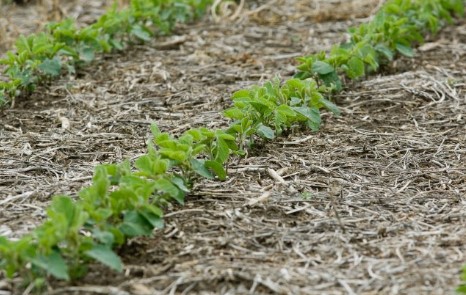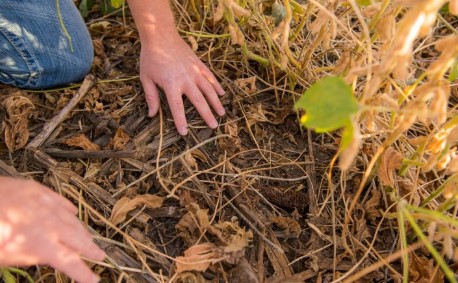Although we all wish there was a snap-your-fingers fix for our saturated field conditions, everyone in agriculture will need to go into the year 2020 with eyes wide open to the realities of our wet weather cycle. Some strategic planning in the off-season can help prepare you for how to best approach the coming spring field conditions.
“Producers definitely need to examine soil and water management immediately,” stated Dennis Todey, director of the USDA Midwest Climate Hub based in Ames, Iowa. Todey spoke to a group of producers, researchers, and tiling contractors gathered at SDSU late last fall for a forum on agricultural water management.
“The regular wetness of soils during these high-traffic times in the field can lead to an increase in compaction issues,” Todey told South Dakota Soybean Leader after the forum. “Uncovered and tilled soils are prone to soil loss during even moderately heavy rains in the spring because of a lack of canopy cover and breakdown of soil structure. That continued loss of soil and soil organic matter leads to loss in production, loss in water-holding capacity, and continued soil degradation. These have to be addressed as soon as possible.”
Todey advises taking a big-picture approach and thinking about improvements that can be made for your farm’s long-term success.
“Longer-term changes should be considered in consultation with advisors looking at larger issues,” he added. “How are these changes in climate impacting my production and operation? How can I reduce those impacts through changes in soil and water management, cropping shifts and rotations, or other longer-term changes?”
Soil compaction worsens in wet conditions
Although the high water table is likely the culprit for our region’s saturated field conditions, SDSU’s Dr. John McMaine encourages growers to examine any underlying issues with their soils.
“The biggest thing to consider is, what’s going on that is preventing or limiting drainage in the first place? Is it a high water table? Then drainage would be a good solution,” McMaine, an Extension Water Management Engineer, commented. “But if it’s more of a soils situation, where the top several inches is a heavy clay or maybe the soil is compacted, then installing drainage won’t address that issue.”

Wet soils are particularly susceptible to compaction. It’s always best to stay out of the field until conditions are right, but when that’s not possible, then minimizing or controlling compaction is your next best management option. University of Minnesota Extension advises the following tips:
- Reduce the number of trips across the field. Wheel traffic is the major cause of soil compaction. Stay off the soil when it’s wet and adopt minimum tillage or no-till practices wherever possible.
- Control your traffic patterns. The first trip across your field accounts for an estimated 70% to 90% of soil compaction. Traveling in those same wheel tracks will create slightly deeper compaction there, but it preserves the profile of the soil between those tracks. Avoid diagonal trips across the field.
- Manage your axle loads. Heavy axle loads on wet soil conditions will increase the depth of the soil compaction. Loads beyond 10 tons per axle increase the potential for compaction past the tillage layer. Large tractors, combines, and grain carts can create compaction down 2 to 3 feet. Keeping axle loads under 10 tons can keep that compaction in the top 6 to 10 inches.
- Optimize your tire pressure. Proper tire inflation not only improves tractor efficiency, but it can reduce the intensity of the soil compaction. When duals or triples are added to a tractor, it reduces the carrying load on each tire, reducing the necessary tire inflation rate. This also decreases the depth and intensity of the compaction
Crunch the numbers on drainage
Experts with the South Dakota NRCS are developing a Drainage Decision Tool to help producers run the numbers on installing tile on specific fields. Mark Larson, hydraulic engineer with the Natural Resources Conservation Service based in Huron, previewed the new tool during the recent SDSU Drainage Forum.

He explained that the tool is housed within a detailed Excel spreadsheet, with some cells open for the user to plug in their data and some cells directly connected to data sets that will be helpful in making calculations. Once the user adds their County and field location information, the spreadsheet connects to the Web Soil Survey, pulling in details on all the types of soils found there and the drainage class for each.
The drainage class will show “acres with little to no benefit” or “acres with potential benefit,” to help users decide whether or not installing drain tile would benefit the field, and if so, whether it would benefit the entire field or only parts of it.
In addition to being connected to the Web Soil Survey, the spreadsheet is paired with data from Mitchell Tech’s annual producer survey to provide some baseline average costs of production. These cells are automated, but there is some opportunity for users to personalize their production costs if they have more specific data.
Larson noted that the Drainage Decision Tool is meant to give a truer comparison of pre- and post-drainage profitability, yield potential pre- and post-drainage, net profit change, and years to payback. The years to payback is based on a 25-year “practice lifespan,” which may be lower than actual but is what NRCS currently uses in its guidelines.
The NRCS Drainage Decision Tool is still in the development phase and not quite ready for public use, according to Larson, as he and his team are still vetting all the information that stands behind the calculations. He’s hopeful that the agency can work with the necessary organizations to finalize the data used, then the Drainage Decision Tool can become a tool used by NRCS field staff.
It could then either be picked up by an organization, business, or university to be further developed, or “it will stand on its own as a tool for starting a discussion on subsurface agricultural tiling,” Larson commented.
Drain tile is one of many useful tools
According to the 2017 U.S. Census of Agriculture, the most recent one available, 3% of South Dakota cropland is now tiled. This may seem like a modest number, but it’s interesting to note that it’s a 69% increase over the 2012 census. South Dakota showed the third highest increased in tiled cropland acres 2012 to 2017, behind a 73% in Kansas and a 109% increase in North Dakota.
Nationwide, a total of 56 million acres were reported as being drained by tile in the 2017 census, up from 49 million acres in the 2012 census. This represents a 14% increase over the 5 years, as well as tile now being present on 14% of U.S. cropland.
SDSU’s Dr. McMaine commented that, in South Dakota, conversations on drain tile often fall into two camps: tile is either the worst thing ever, or the best thing ever. “In South Dakota, there’s a pretty even split,” he observed of people’s views.
“I think people need to view it more as a tool,” Dr. McMaine continued. “It is not a perfect solution, but it is a useful tool. Figuring out how it fits in each individual’s operation and installing it in a way that can manage water both in the wet times and the dry times.”
Dr. McMaine is a proponent of controlled drainage, which allows more options for managing your water table at different times of the year and in different moisture conditions.
Drainage Water Management (DWM), as described by the NRCS, is the process of managing the timing and the amount of water that discharges from ag drainage systems. A structure for water control is installed in the tile line, which allows for management of the tile outlet elevation. DWM works best on very flat ground, but still may provide value on a variety of field conditions.
By stacking or lowering riser boards within the water control structure, the water table can be raised or lowered depending on land-use needs. Spring and fall, water table levels could be lowered to allow more optimal field work conditions. Mid-year, levels could be brought up, if needed, to bring moisture to developing roots.
Talk to your local NRCS office about developing a Drainage Water Management plan, or talk to your tiling contractor about adding the necessary components to your system.
Build up your soils
In our current wet weather cycle, water infiltration rate and water-holding capacity will be critically important to our soils. Dr. McMaine encourages producers to look at introducing more organic matter into your system, using higher biomass crops, trying cover crops, and employing minimal tillage.
“Organic matter is kind of a win-win for both wet and dry cycles,” he commented, noting that you get better water infiltration but also better water-holding capacity.
He acknowledges that these changes take some time to implement, but long-term the benefits will definitely be felt.
“In general, improving the ability to manage water also improves the ability to manage a lot of other things down the road,” McMaine commented.
Marcia Deneke, NRCS Conservation Agronomist, offers a couple pieces of advice for wet conditions as well.
“If we anticipate saturated conditions in the spring, and the opportunity arises, producers can potentially dormant seed a cool-season cover crop,” Deneke said. “This would allow it to start growing and utilize some of the water prior to planting a cash crop.”
She noted that producers would need to follow the cover-crop termination guidelines to meet crop insurance requirements, and work with their crop insurance agent to ensure that the termination guidelines are met.
“Another consideration would be to select a moderate- to deep-rooted, high water-use cash crop or perennial vegetation in those portions of the field that are annually the wettest,” Deneke added, such as alfalfa, corn, safflower, sunflower, spring wheat, or oats.
“Another consideration would be to select a moderate- to deep-rooted, high water-use cash crop such as corn, safflower, sunflower, spring wheat, or oats. In those areas that are annually wet, it may be beneficial to plant perennial vegetation in or adjacent to those portions of the field to use or intercept excess moisture,” Deneke added. “We need to think about managing our crop field at the sub-field level.”
Click here to see more...